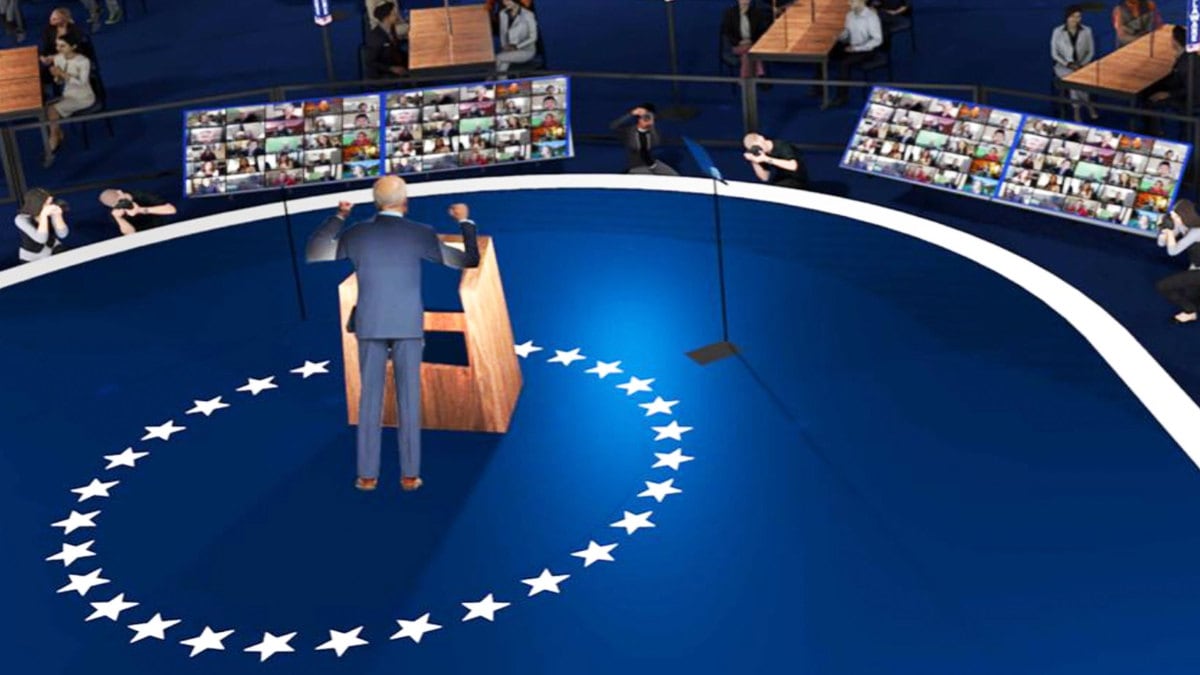Airtime cut in half. A Zoom-style backdrop the size of a tennis court. Celebratory car-honking. And most of it won’t even be in the host city.
These are the Democratic National Committee’s current plans for the party’s convention in four weeks, according to a ten-page preview outline for the event obtained by The Daily Beast. The plans, marked for internal use only, feature digital renderings of convention attendees seated at distant tables and separated by see-through partitions, a “Convention Across America” speaking lineup that is both dramatically shorter in length and vastly more ambitious in scale, and a program that emphasizes former Vice President Joe Biden, the party’s presumptive nominee, to a degree rarely seen in national political conventions.
“The 2020 Democratic National Convention is being re-imagined to connect with voters from across America using satellite events from the swing states that are linked to a working convention floor in Milwaukee,” the deck reads, with the goal of positioning Biden “as the right leader for this moment, to lead us out of crisis, bring us together, and build toward a kinder, stronger, and better America.”
As expected, the convention, which begins on August 20, amounts to a radical departure from traditional party convention planning, with an emphasis on digital participation by delegates, speakers, and attendees. Held amidst the coronavirus pandemic that has upended the Democratic primaries since March, the convention will primarily feature speakers, video, and images beamed in from outside Milwaukee’s Wisconsin Center, and largely from outside the state.
According to the plan, while the convention will feature “major programmatic elements” each night of the convention, one or more of the “main” speakers each night will address the nation from an unnamed “message-based location” in swing states around the country.

The current slate of speakers, according to those familiar with the DNC’s planning, includes former first lady Michelle Obama and Vermont Sen. Bernie Sanders speaking on the convention’s first night, Dr. Jill Biden delivering remarks on the second night, the as-yet-unnamed running mate speaking on the third night, and finally Biden’s acceptance speech on the final night of the convention. Of those, only Biden is currently expected to speak from the convention state in Milwaukee.
Among the others reportedly set to speak include Republican Gov. John Kasich of Ohio, likely on the first night of the convention, with other “surprise” speakers as well.
For the few who will be on-site in Milwaukee, renderings of the convention stage show a set reimagined for the Zoom age, with a 64-panel screen for delegates, dignitaries, and Americans from key demographics to participate in the roll-call vote.
The roll call is currently set to take place remotely and live, broadcast from “iconic or message-based locations in 57 states and territories across America,” the deck reads, starting from the Edmund Pettus Bridge in Alabama, the site of the “Bloody Sunday” protest against segregation in 1965. In addition to party delegates and high-ranking Democrats, the roll call vote will also be reported by “a variety of voices,” with examples including a DREAMer, a Teamster, and first responders.
The roll call vote will conclude with a “big celebratory moment,” according to the deck, featuring a surprise musical act, fireworks, and “people in their cars honking and flashing lights.”
Reached for comment about the plans, Katie Peters, the communications director for the Democratic National Convention Committee told The Daily Beast that Democrats are “exploring all options to host an inspiring event that unites the nation around Joe Biden's vision for America. Our plans are not yet confirmed and will continue to take shape over the next several weeks as we make adjustments to best protect public health.”
Despite the shortened broadcast time and remote-broadcast plan, the DNC is still making a major fundraising play for the slimmed-down convention, which has a budget of $20 million—compared to the $86 million convention in Philadelphia four years ago.
Even with its smaller pricetag, fundraising for a massive event that’s nearly entirely digital has proved to be tricky for the DNC. During normal conventions, major donors can expect a plush suite near the center of the action, with exclusive events and opportunities to network with the likely leaders of the next administration. But the perks of cutting a major check to the Democratic National Convention Committee aren’t in play this year—rubbing shoulders being pretty much the opposite of social distancing—and with one month until opening night, the DNCC is still seeking to raise north of $8 million for the convention, according to a Democratic donor who has been asked to kick in for the event.
Despite the slashed budget and airtime, a few aspects of the convention will continue as they would in a normal election year. Each night of the convention features a generically patriotic theme—“A United America” for the first night, “A Future for All” for the third night—and the convention program still aims to highlight issues at the top of Democratic concerns, including racial justice, gun violence, health care, voting rights and the environment.
But the event will still be a jarring contrast to the business-as-usual—albeit slimmed down—Republican National Convention set to take place the following week in Jacksonville, Florida, which has local elected Republicans worried that the party’s biggest fête of the election cycle will amount to a star-studded superspreader event.
The Democratic convention, meanwhile, will be broadcast for a mere two-to-three hours per night, rather than the usual six-hour speech-a-thon, with an emphasis on pre-recorded segments, which the DNC says in the deck will allow it “to keep the message tight and integrated,” more of a mini-movie than “a series of long speeches.”
The programming is currently set to be more candidate-centric than recent conventions, which typically hold back on emphasizing the nominee until the closing night. Potential moments for the convention, according to the deck, include clips of Biden throughout the years, with one “framing clip” intended to highlight the theme of the evening. There will be a total of five biographical videos about the former vice president, as well as pre-taped segments—basically commercials—featuring Biden “having intimate, unscripted, and potentially tough conversations” with voters about the future of the country.
President Donald Trump, meanwhile, will largely be relegated to interstitial “contrast” videos, lest the convention turn into a four-night screed against the president. “Time is better spent talking about what America ‘can’ be under the experienced and steady leadership” of the former vice president, according to the DNC’s plan.
“With the new ‘virtual’ format, viewers are unlikely to tune in night after night to hear Trump bashing,” the deck declares.






